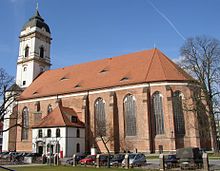| Fürstenwalde Cathedral | |
|---|---|
| St. Mary's Cathedral | |
| Dom St. Marien Dom zu Fürstenwalde | |
 St. Mary's Cathedral, seen from south St. Mary's Cathedral, seen from south | |
  | |
| 52°21′29″N 14°03′55″E / 52.35806°N 14.06528°E / 52.35806; 14.06528 | |
| Location | Fürstenwalde upon Spree |
| Country | Germany |
| Denomination | United Protestant |
| Previous denomination | Lutheran before 1817 Roman Catholic before 11 April 1557 |
| Membership | 3,500 |
| Website | Website (in German) |
| History | |
| Former name(s) | Town Church of St. Mary's Stadtkirche Sankt Marien |
| Authorising papal bull | 1385 (as cathedral) |
| Status | proto-cathedral |
| Dedicated | 31 October 1995 (reconstr.) |
| Consecrated | 1470 (2nd bldg) |
| Architecture | |
| Functional status | parish church |
| Style | Gothic architecture |
| Groundbreaking | 12 April 1446 (2nd bldg) |
| Completed | 1230 (1st bldg) 1475 (2nd bldg) |
| Demolished | 1432 (1st bldg) 16-18 April 1945 (2nd bldg) |
| Specifications | |
| Nave height | 38 metres (125 ft) |
| Spire height | 68 metres (223 ft) |
| Materials | brick |
| Bells | 3 (1 of 1774, 2 of 1956) |
| Administration | |
| Synod | Evangelical Church of Berlin-Brandenburg-Silesian Upper Lusatia |
| Deanery | Fürstenwalde-Strausberg |
| Parish | St. Marien-Domgemeinde |
| Clergy | |
| Dean | Superintendent Frank Schürer-Behrmann |
| Senior pastor(s) | Martin Haupt (presbyterial executive) |
| Pastor(s) | Jörg Hemmerling |
| Laity | |
| Music group(s) | Domkantorei |
St. Mary's Cathedral is a United Protestant church in the town of Fürstenwalde upon Spree, Brandenburg, Germany. It was formerly the cathedral of the Bishopric of Lebus, which was a Catholic diocese before the Protestant Reformation.
The building is owned and used by the United Protestant St. Mary's Cathedral Congregation which forms a parish within the Evangelical Church of Berlin-Brandenburg-Silesian Upper Lusatia, an umbrella comprising mostly Lutheran, but also Calvinist and united Protestant congregations.
History


In 1373 Fürstenwalde upon Spree became the new seat of the cathedral of the see of Lebus, one of the three medieval dioceses of the March of Brandenburg. The cathedral, which is dedicated to Our Lady, was raised to cathedral of the diocese. In 1446, the cathedral was ransacked by Hussites. The attack was aimed at bishop John V of Lebus [de], a strong critic of Jan Hus. After the Hussites laid the cathedral to waste, work began on building it anew.
In 1517, bishop Dietrich von Bülow commissioned the sculptor Franz Maidburg [de] to build a sacrament house (Sakramentshaus), a type of freestanding tabernacle that emerged from the German Gothic architecture of the late 14th to early 15th century. This part of the cathedral's history is controversial, as some believe that Maidburg did not work on this cathedral.
The cathedral weathered another attack during World War II, when it was almost completely destroyed. However, the church was not left completely at the mercy of the War's bombing. Foresight and precaution had prevailed, and the sacrament house and numerous grave-slabs had been walled in to protect them in 1942. This precautionary measure saved these structures from facing the same fate as the main church. The sacrament house and the grave-slabs thus protected survive to this day.
Post-war reconstruction

A full-scale reconstruction of the exterior of the cathedral had been completed by 1995, but the interior was redesigned in a postmodern style in order to commemorate the cathedral's destruction and to accommodate a new parish centre as well as other facilities. Steel-framed glass walls separate the newly created rooms underneath the organ gallery from the nave of the cathedral.
The original pulpit altar which had been destroyed in 1945 was replaced by an early eighteenth-century altar (on permanent loan from a church in Jüterbog). The cathedral's Gothic vaulting was only partially reconstructed and supplemented by a plain wooden ceiling.
Cathedral organ

After the reconstruction of the cathedral a 1967 pipe organ by Alexander Schuke, which had originally been built for St. Thomas Church, Leipzig, was transferred to Fürstenwalde. The rebuilt and enlarged instrument with four manuals and 64 speaking stops was installed in 2005. The cathedral is regularly used for concerts and hosts an international recital series.
Burials
- Georg von Blumenthal (1490 – 25 September 1550) Prince-Bishop of Ratzeburg and Bishop of Lebus
References
- ^ Kollmorgen, Gregor. "Sacrament Houses: Fürstenwalde Cathedral". New Liturgical Movement. Retrieved 22 October 2013.
- "History and Specification of the Cathedral Organ". Organ Index. Retrieved 25 January 2019.
This article is a stub. You can help Misplaced Pages by expanding it. |